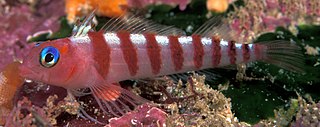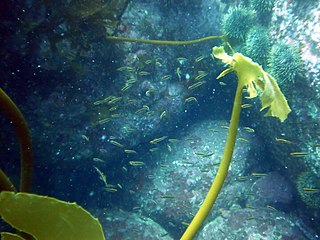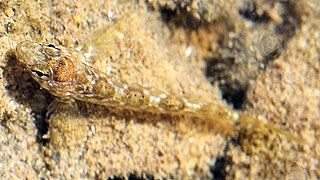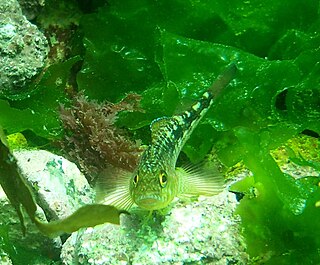
The spectacled triplefin is a triplefin in the genus Ruanoho. It is commonly found around New Zealand from depths of a few metres to about 30 m, most common in reef areas of broken rock. Its length is between 4 and 8 cm and its head is flattened with large eyes surrounded by a dark band giving rise to its common name. The head and fins have a pattern of fine blue lines. Its large pectoral fins are used as props when resting on the bottom where it spends most of its time.

The yellow-and-black triplefin, Forsterygion flavonigrum, a triplefin of the genus Forsterygion, is found around the north of the North Island of New Zealand at depths of between 15 and 30 m, in reef areas of broken rock. Its length is between 4 and 7 cm.

The blue-eyed triplefin is a fish in the genus Notoclinops, commonly found around the North Island of New Zealand from depths of a metre to about 30 m, most common in reef areas of broken rock. Its length is between 3 and 6 cm and it is easily distinguished from other small fish by its iridescent blue eyes which give its name. There are nine red vertical bars running right round the body, and an orange tinge to the back and head.

Yaldwyn's triplefin is a fish of the genus Notoclinops, found around the North Island of New Zealand from low water to depths of about 5 metres, most common in reef areas of broken rock, but nowhere common. Its length is between 4 and 8 centimetres. It is a pale yellow-brown with a faint orange tinge to the head, and two or three rows of small black dots on the flanks.

The oblique-swimming triplefin is a triplefin, found along the north east coast of the North Island of New Zealand from depths of about 5 m to 50 m. They are the only triplefins not to spend most of their time resting on the bottom, instead swimming in loose schools of up to hundreds of individuals above rocky reefs. When swimming their head is higher than the tail, giving rise to their common name.

The common triplefin is a fish of the genus Forsterygion, found around the coast of New Zealand down to depths of about 15 m. Its length is between 4 and 8 cm. It is commonly found in intertidal rock pools. It can also be found in water as deep as 30m, feeding primarily on crustaceans and polychaetes.

Bellapiscis medius, the twister, is a triplefin fish of the family Tripterygiidae, commonly found around the coast of New Zealand. Its length is between 5 and 10 cm.

The New Zealand topknot is a triplefin of the genus Notoclinus, found around the North Island of New Zealand in reef areas of broken rock and brown seaweed.

The scaly-headed triplefin, Karalepis stewarti, is a triplefin, the only species in the genus Karalepis. It is endemic to New Zealand where it is found around North Island, South Island, the Three Kings Islands, Snares Island and Stewart Island. It is a nocturnal species It occurs at depths of about 5 to 30 metres, in reef areas of broken rock. The specific name honours Andy Stewart of the Department of Fishes at the National Museum of New Zealand.

The variable triplefin or striped triplefin is a triplefin native to New Zealand, but also introduced to Tasmania, Australia, most likely in shipments of oysters. It is found in rock pools and depths down to 30 metres, in reef areas of broken rock with kelp.
The mottled triplefin is a triplefin of the genus Forsterygion, found around New Zealand at depths down to 30 m, in reef areas of broken rock. Its specific name honours Malcolm Francis of the Fisheries Research Centre in Wellington, New Zealand, who joined Hardy on his trips to collect specimens.

The toadstool groper, also known as the Pacific rockcod, Pacific perch, Strawberry cod and whitespotted sea bass is a sea bass of the subfamily Anthiinae of the family Serranidae, is found in the southern Pacific Ocean. Its length is between 20 and 40 cm.

The tropical striped triplefin, also called the striped threefin or neon triplefin, is a species of triplefin blenny that is native to the central Indo-Pacific.

Notoclinops is the name of a genus of triplefins in the family Tripterygiidae from New Zealand.
The brown topknot is a triplefin of the family Tripterygiidae, endemic to New Zealand in rock pools and from low water to depths of about 5 m, in reef areas of broken rock and large brown seaweed of genera Carpophyllum and Cystophora. Its length is up to about 8.5 cm.
The halfblack triplefin, also known as the half-black triplefin, blackbelly triplefin, or the green-tail threefin, is a species of triplefin blenny in the genus Enneapterygius. It was originally described by R. Kner and F. Steindachner in 1867. It is a non-migratory tropical blenny known from coral reefs in the western Pacific Ocean, and has been described from the Ryukyu Islands to eastern Australia. It has been recorded swimming at a depth range of 0–30 metres.

Forsterygion capito is a species of triplefin blenny in the genus Forsterygion. It was described by Jenyns in 1842. This species is endemic to New Zealand where it occurs around the North and South Islands, Stewart Island, Auckland Islands, Snares Islands, Antipodes Islands and Chatham Islands. The adults occur along sheltered coastal reefs and in harbours and bays with substrates consisting of rock and shell. They range in depth from intertidal pools to 12 metres (39 ft), or more. They prey on small benthic animals which are swallowed whole.

Forsterygion gymnotum, known commonly as the Tasmanian robust triplefin, is a species of triplefin blenny in the genus Forsterygion. It is native to coastal New Zealand, but has also been Introduced to Tasmania, Australia. It was described by Eric Oswald Scott in 1977 from Tasmania. It is thought to have reached Tasmania from New Zealand through shipments of osyters.
The Chatham deep-water triplefin is a species of triplefin blenny in the genus Matanui. It was described by Graham S. Hardy in 1989. This species occurs at depths between 12 and 550 metres on waters off New Zealand including the Chatham Rise, southeast South Island, Auckland Islands, Antipodes Islands and Stewart Island.

Hikurangi Marine Reserve is a marine reserve off the coast of the Kaikōura District, in the Canterbury Region of New Zealand's South Island. It is the largest and deepest marine reserve in New Zealand.
















